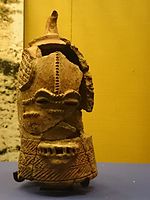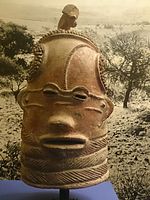Lydenburg Heads

The Lydenburg heads are the earliest known examples of African sculpture in Southern Africa.
|
|
 |
|
| Material | terracotta |
|---|---|
| Created | African Iron Age A.D. 500 |
| Discovered | Lydenburg, Mpumalanga, South Africa |
| Present location | Iziko South African Museum, Cape Town |
The Lydenburg Heads refer to seven terracotta heads that were discovered in association with other pottery artefacts in Lydenburg, Mpumalanga, South Africa. They are among the oldest known African Iron Age artworks from below the equator. Other artefacts found in association with these heads include ceramic vessels, iron and copper beads, and bone fragments. Charcoal associated with the heads was Radiocarbon dated, and this relative dating technique places these artefacts and the site at around 1410 BP (approximately 500 A.D.), which constitutes one of the earliest dates for an Iron Age settlement in South Africa.
The heads were discovered initially as a surface find by a young boy named Ludwig Von Bezing while playing on his fathers farm. The material was later collected when Ludwig was a teenager. He went back in both 1962 and 1966 to excavate the area and during this time he was able to find several pieces of pottery that proved to be seven hollow heads when assembled, two of which can fit over a child's head; only one out of the seven heads resembles an animal.
The recovered pottery sherds were reconstructed largely at the University of Cape Town, and assembled to comprise two large heads and five smaller heads. One of the larger heads constitute an incomplete specimen. The reconstructed heads provide a glimpse into the craftsmen's skill and preciseness of artistry, even though they may not look exactly how they looked 1500 years ago. Six of the heads share human characteristics, while a single head has animal-like features. The presence of linear patterned neck rings are postulated to represent a marker of prosperity or wealth, due to their symbolic use throughout time. Of the seven, only two are large enough to have been worn, but the size is not the only observable variation between them. The two aforementioned heads constitute the only specimens with small animal figurines, perceived to be lions, mounted on top of them. The other five are more similar in size and appearance, with one exception. This head is the only head that seems to resemble something other than a human. It has a long snout instead of regular protruding lips and also has no ears. Documentation of associated artefacts was limited due to the primary significance of the heads; however, we do know that the associated pottery sherds were identified as terracotta.
...
Wikipedia
